"The Rookie" Bats $22,565,000
May 22nd, 2014
|
Norman Rockwell’s The Rookie (Red Sox Locker Room), oil on canvas, 41" x 39", painted in 1957, sold for $22,565,000 (est. $20,000,000/30,000,000) to a phone bidder. Reportedly the consignor had turned down an offer of $30,000,000 (or more), preferring the risk of auction. Rockwell painted it for the March 2, 1957, cover of Saturday Evening Post. According to the catalog, Frank Sullivan, Billy Goodman, Sam White, and Jackie Jensen all drove to Stockbridge, Massachusetts, to be posed and photographed for the painting, and images of Ted Williams were sent from the Red Sox office. For the rookie, Rockwell hired 18-year-old Sherman “Scottie” Safford, who had moved with his family as a youth in the 1950s from southern California to Pittsfield, Massachusetts. The image expresses youth versus experience, and Rockwell’s version of Ted Williams does not seem to welcome a challenger. Like many of Rockwell’s illustrations it champions the underdog. The palm trees seen through the window locate the scene in Florida for spring training.
Stuart Davis (1892-1964)signed Anchors on the upper left and signed again and dated it “Dec. 1930” with the title on the stretcher. The painting sold in the salesroom for $1,805,000 to New York City dealer John Driscoll of Driscoll/Babcock Galleries. It had sold at Christie’s on December 5, 2002, for $779,500 and is one of a series of Davis’s paintings inspired by Gloucester, Massachusetts, where the artist used nautical forms, linear patterns, and subtle colors to create abstract compositions that define the place and time.
This charming pencil on paper, 9½" x 13", is signed and dated “June 1873” by Winslow Homer (1836-1910). The Boat Builders sold in the salesroom for $701,000 (est. $250,000/350,000) to Ossining, New York, art dealer Gerold Wunderlich, underbid by a phone bidder. The drawing was consigned by the estate of J. Carter Brown III (1935-2002), the longtime director of the National Gallery of Art.
Winslow Homer (1836-1910) signed A Shady Spot, Houghton Farm with an initial and the date 1878. The 7" x 8¼" watercolor and gouache on paper sold for $965,000 (est. $600,000/800,000) to an American collector on the phone.
Two phone bidders competed for New York by Henry Koerner (1915-1991).Koerner painted the 19¾" x 24" oil on board circa 1948. It sold for $68,750 (est. $20,000/30,000).
Norman Rockwell (1894-1978), Spirit of America, oil on canvas, 21¾" x 57¾", sold on the phone for $1,085,000 (est. $300,000/500,000). Painted for the Franklin Mint in 1974 for a limited-edition print series, it applauds the diversity of what makes up the nation, various ages, genders, and races, against an American flag, with green pastures and blue sky in the background. Rockwell includes his self-portrait and that of his wife in the lower left.
Edward Hopper (1882-1967), Coast Guard Boat I, watercolor and pencil on paper, 14" x 20", signed “Edward Hopper/ Two Lights, Me.” It sold for $1,745,000 (est. $1,000,000/1,500,000). Hopper painted it in 1929 in Cape Elizabeth, Maine, where he periodically summered and painted. |
Christie’s, New York City
Photos courtesy Christie’s
On May 22, Christie’s sold The Rookie, Norman Rockwell’s celebrated painting of a Red Sox locker room during spring training, for $22,565,000 (with buyer’s premium) to a phone bidder. It was estimated at $20,000,000/30,000,000. Reportedly the consignor turned down a higher offer sometime between December and May, preferring the risk of auction to a private sale.
In preparation for painting this work, used for the March 2, 1957, cover of the Saturday Evening Post, Rockwell posed and photographed Red Sox players Frank Sullivan, Billy Goodman, Sam White, and Jackie Jensen. They had driven to Stockbridge, Massachusetts, and did not know who Rockwell was. Images of Ted Williams were sent from the Red Sox office. Reference photos exist, and some of them were published in Christie’s catalog. Rockwell went to Sarasota to see the training facility and made detailed notes and sketches. The palm leaf seen through a window in the painting sets the scene in Florida. For the rookie, Rockwell hired from the high school in Pittsfield, Massachusetts, the tallest guy he saw, 18-year-old Sherman Safford, who had known of Rockwell in his previous home in southern California. Stafford, now 75, was interviewed by the Berkshire Eagle and on national TV after the sale. He told reporters, “Rockwell paid me sixty dollars for each posing session. I wish I had kept those checks. They might be worth more than that now.” Rockwell’s portrayal of Ted Williams gives the impression that Williams doesn’t welcome the rookie. Like many of Rockwell’s illustrations, The Rookie champions the underdog.
Before the sale, Judy Goffman Cutler, a New York City dealer and founder with her husband, Laurence Cutler, of the National Museum of American Illustration in Newport, Rhode Island, said, “If Saying Grace sold for forty-six million dollars, The Rookie should bring fifty-six million.” She said she had sold the painting in 1982 for around $600,000 to an agent for the consignor. In December 2013 it was the centerpiece in a special exhibition of work by American illustrators hung in Christie’s private sales gallery, but it was not for sale then.
Auctions are unpredictable. Norman Rockwell’s Spirit of America, painted for the Franklin Mint in 1974 for a limited-edition print, failed to sell when it was offered at Sotheby’s in 2004 (est. $500,000/700,000) but sold at this sale, a decade later, for $1,085,000 (est. $300,000/500,000). The Collector, also commissioned by the Franklin Mint, was painted by Rockwell in 1971 and sold for $965,000 (est. $700,000/1,000,000) to New York City dealer Michael Altman.
Altman also bought Coast Guard Boat I by Edward Hopper, a 1929watercolor on paper, for $1,745,000 (est. $1,000,000/1,500,000). (Incidentally, the Norman Rockwell Museum in Stockbridge, Massachusetts, has The Unknown Hopper: Edward Hopper as Illustrator on view through October 26.)
Anchors,painted by Stuart Davis in 1930 as one of a series of paintings with nautical imagery inspired by Gloucester, Massachusetts, sold to New York City dealer John Driscoll in the salesroom for $1,805,000 (est. $1,500,000/2,500,000). With crisp, abstract design, Davis summed up Gloucester and sailing in nautical colors. Some thought it would bring more.
The most competitive bidding at Christie’s was for Thomas Moran’s The Grand Canyon of the Colorado, a 29½" x 60" painting completed in 1904, late in Moran’s career, that captures the splendor of the natural wonder with a storm approaching. It sold on the phone to a collector for $12,485,000 (est. $8,000,000/12,000,000). Shown alone in a large gallery during the five-day presale exhibition, it had a huge presence. With no human or animal in the picture, the grandeur of the landscape felt heightened. Moran painted this majestic scene often and in many sizes. This painting relates to Moran’s Chasm of the Colorado, 1873-74, painted as the pendant to Grand Canyon of the Yellowstone, Moran’s first monumental Western landscape, which Congress purchased for the U.S. Capitol in 1872. Both paintings are now at the Smithsonian American Art Museum, lent by the Department of the Interior Museum. Painted from a similar vantage point, both paintings of the Grand Canyon are breathtaking panoramas. Moran’s paintings were vital to the creation of our national park system.
American painting sales offer works for many tastes. Milton Avery’s figuratively abstract style, using flat patterns of saturated color, is enormously popular. Siesta, a figure reclining on a yellow sofa, sold for $1,565,000 (est. $1,000,000/1,500,000) and Mandolin Player, from the estate of Edgar Bronfman Sr., sold for $1,445,000 (est. $800,000/1,200,000). Not every Avery brings a seven-figure price, and some less-successful works by Avery did not sell.
There are plenty of collectors for works by Winslow Homer. Homer’s A Shady Spot, Houghton Farm, a 7" x 8¼" watercolor and gouache on paper, initialed and dated 1878, sold for $965,000 (est. $600,000/800,000) to an American collector on the phone. Homer painted this nostalgic scene of rural life during an extended stay at Houghton farm, the home of his first and, aside from his family, most important patron, Lawson Valentine, a varnish manufacturer who eventually owned 44 works by the artist. The Boat Builders, an intimate and lovely 9½" x 13" pencil drawing by Homer of two young boys on a rocky beach, signed and dated by the artist in June 1873, sold in the salesroom for $701,000 to art dealer Gerold Wunderlich of Ossining, New York, underbid on the phone. It was consigned by the estate of J. Carter Brown III, longtime director of the National Gallery of Art.
Two Luminist paintings by Francis Augustus Silva found buyers. October on the Hudson, a large oil on canvas from the early 1870s, sold on the phone for $941,000 (est. $700,000/1,000,000). Its polished and meticulous realism without a sign of a brush stroke is classic Luminism. John Wilmerding called Luminism the counterpart to writings by Ralph Waldo Emerson and Henry David Thoreau in his 1980 catalog of the exhibition American Light: The Luminist Movement 1850-1875 at the National Gallery of Art in Washington, D.C. Silva painted this large-scale work from sketches in his New York studio. A slightly smaller work by Silva, offered without reserve, sold later in the sale for $233,000 (est. $500,000/700,000) to an on-line bidder from Texas, underbid in the salesroom by dealer Michael Altman.
After a long lunch break, Christie’s offered lesser works with lower estimates with mixed success. Illustration art continued to perform well with works by Norman Rockwell and N.C. Wyeth finding buyers. Rockwell’s painting of his daughter, The Artist’s Daughter (Little Girl with Palette and Easel), a 34" x 30" oil on canvas, sold for $725,000 (est. $500,000/700,000) to a phone bidder. It was painted in 1919 and appeared on the cover of the Literary Digest in September 1922. In 1929 Newell Convers Wyeth (1882-1945) painted Odysseus and Calypso in oil on canvas, 48" x 38", as an illustration for a translation of The Odyssey. It sold to art advisors in the salesroom for $581,000 (est. $500,000/700,000). In May 2008, it had sold at Sotheby’s for $397,000 to New York collectors, the consignors.
 Pictures of specific places are popular with collectors. A Fern Coppedge Village Landscape sold for $72,500 (est. $30,000/50,000). A 15" x 56" view by Rackstraw Downes of Atlantic Avenue at the Entrance to the Van Wyck Expressway, painted in 2007, sold for $40,000 (est. $20,000/30,000). Paul Cornoyer’s Winter Bryant Park, 8" x 10" and in its original Newcomb-Macklin Company frame, sold for $30,000 to New York City dealer Debra Force in the salesroom. For a client, Force also bought Andrew Wyeth’s study for Hand Lines, a watercolor on paper, for $62,500 (est. $50,000/70,000).
Pictures of specific places are popular with collectors. A Fern Coppedge Village Landscape sold for $72,500 (est. $30,000/50,000). A 15" x 56" view by Rackstraw Downes of Atlantic Avenue at the Entrance to the Van Wyck Expressway, painted in 2007, sold for $40,000 (est. $20,000/30,000). Paul Cornoyer’s Winter Bryant Park, 8" x 10" and in its original Newcomb-Macklin Company frame, sold for $30,000 to New York City dealer Debra Force in the salesroom. For a client, Force also bought Andrew Wyeth’s study for Hand Lines, a watercolor on paper, for $62,500 (est. $50,000/70,000).
The total for Christie’s two sessions of the day was a respectable $64,006,000 for 115 of the 167 lots offered. Elizabeth Sterling, head of American art at Christie’s, sees strength in the market, especially illustration and Western art and works from estates fresh to market. She is pleased that American art has an international audience. “Asian buyers compete for Rockwell and for Andrew Wyeth,” she said.
For more information, contact Christie’s at (212) 636-2000 or on line at (www.christies.com).
|
|
|
|
|
|
|
|
American Paintings from the Clark Collection
On June 18, Christie’s offered two American pictures from the estate of the Huguette Marcelle Clark (1906-2011) in a Clark estate sale. They might otherwise have swelled the total of the American paintings sale and were illustrated in the American art catalog.
|
|
|
|
Originally published in the August 2014 issue of Maine Antique Digest. © 2014 Maine Antique Digest

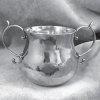




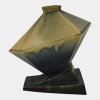



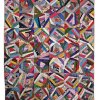








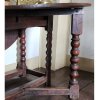


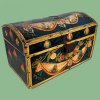

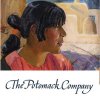




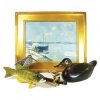





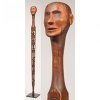
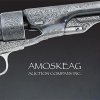


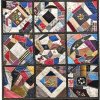


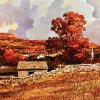









 Milton Avery (1885-1965) signed and dated The Mandolin Player in 1946 (lower right). The 36" x 28" oil on canvas laid down on board sold to a phone bidder for $1,445,000 (est. $800,000/1,200,000). The painting was from the estate of Edgar Bronfman Sr. (1929-2013), a renowned Canadian-American philanthropist and businessman and CEO of Distillers Corporation-Seagrams Ltd. The painting was a favorite during the preview. It demonstrates Avery’s signature style of translating his subjects into flattened, abstracted two-dimensional spaces and his subtle use of color.
Milton Avery (1885-1965) signed and dated The Mandolin Player in 1946 (lower right). The 36" x 28" oil on canvas laid down on board sold to a phone bidder for $1,445,000 (est. $800,000/1,200,000). The painting was from the estate of Edgar Bronfman Sr. (1929-2013), a renowned Canadian-American philanthropist and businessman and CEO of Distillers Corporation-Seagrams Ltd. The painting was a favorite during the preview. It demonstrates Avery’s signature style of translating his subjects into flattened, abstracted two-dimensional spaces and his subtle use of color. Thomas Moran (1837-1926), The Grand Canyon of the Colorado,29½" x 60", oil on canvas. It is signed with the artist’s conjoined initials and dated 1904 and sold on the phone for $12,485,000 (est. $8,000,000/12,000,000). It was painted nearly 30 years after Moran first visited the Grand Canyon as a member of John Wesley Powell’s 1873 expedition, when he planned a pendant to his painting Grand Canyon of the Yellowstone, which Congress had purchased for the Capitol in 1872. This is a later version of a similar majestic scene, with no human or animal presence, and with the heightened drama of a storm coming over the mountains, which conveys the grandeur of the landscape. It captured the imagination of the American public when it was painted and still does. It had last sold at Sotheby’s in November 1990 for a record $1,045,000 during a recessionary time. The $12,485,000 is not a record for the artist. Thomas Moran’s Green River of Wyoming sold at Christie’s in May 2008 for $17,737,000, which set a record for the artist and for any 19th-century American art at auction.
Thomas Moran (1837-1926), The Grand Canyon of the Colorado,29½" x 60", oil on canvas. It is signed with the artist’s conjoined initials and dated 1904 and sold on the phone for $12,485,000 (est. $8,000,000/12,000,000). It was painted nearly 30 years after Moran first visited the Grand Canyon as a member of John Wesley Powell’s 1873 expedition, when he planned a pendant to his painting Grand Canyon of the Yellowstone, which Congress had purchased for the Capitol in 1872. This is a later version of a similar majestic scene, with no human or animal presence, and with the heightened drama of a storm coming over the mountains, which conveys the grandeur of the landscape. It captured the imagination of the American public when it was painted and still does. It had last sold at Sotheby’s in November 1990 for a record $1,045,000 during a recessionary time. The $12,485,000 is not a record for the artist. Thomas Moran’s Green River of Wyoming sold at Christie’s in May 2008 for $17,737,000, which set a record for the artist and for any 19th-century American art at auction.  Fern I. Coppedge (1883-1951), Village Landscape, a 16" x 20" oil on canvas, sold for $72,500 (est. $30,000/50,000).
Fern I. Coppedge (1883-1951), Village Landscape, a 16" x 20" oil on canvas, sold for $72,500 (est. $30,000/50,000).  Rackstraw Downes (b. 1939) painted Atlantic Avenue at the Entrance to the Van Wyck Expressway in 2007. The 15" x 56" oil on joined canvas sold for $40,000 (est. $20,000/30,000).
Rackstraw Downes (b. 1939) painted Atlantic Avenue at the Entrance to the Van Wyck Expressway in 2007. The 15" x 56" oil on joined canvas sold for $40,000 (est. $20,000/30,000).






